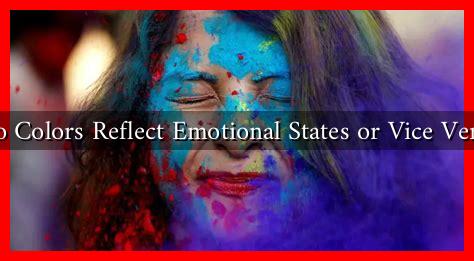-
Table of Contents
Do Colors Reflect Emotional States or Vice Versa?
The relationship between colors and emotions has fascinated psychologists, artists, and marketers for decades. The question remains: do colors reflect our emotional states, or do our emotions influence how we perceive colors? This article delves into the intricate interplay between colors and emotions, exploring scientific studies, cultural implications, and practical applications.
The Psychology of Color
Color psychology is a field that studies how colors affect human behavior and emotions. Different colors are often associated with specific feelings, which can vary across cultures. For instance, red is frequently linked to passion and anger, while blue is associated with calmness and serenity. Here are some common associations:
- Red: Energy, passion, danger
- Blue: Trust, tranquility, sadness
- Yellow: Happiness, optimism, caution
- Green: Growth, harmony, envy
- Purple: Luxury, creativity, mystery
Research indicates that these associations can influence our emotional states. For example, a study published in the journal *Emotion* found that participants exposed to the color red were more likely to feel excited and energized compared to those in a blue environment. This suggests that colors can indeed reflect and evoke emotional states.
Emotional States Influencing Color Perception
While colors can evoke emotions, the reverse is also true: our emotional states can influence how we perceive colors. When individuals are feeling happy, they may perceive colors as more vibrant and saturated. Conversely, when someone is feeling down, colors may appear duller and less appealing. This phenomenon is supported by research in the field of affective science.
For instance, a study conducted by researchers at the University of California, Berkeley, found that individuals in a positive emotional state were more likely to describe colors in a more vivid and enthusiastic manner. This suggests that our emotional states can alter our perception of color intensity and brightness.
Cultural Influences on Color and Emotion
Cultural context plays a significant role in how colors are perceived and the emotions they evoke. Different cultures have unique associations with colors, which can lead to varying emotional responses. For example:
- In Western cultures, white is often associated with purity and weddings, while in some Eastern cultures, it symbolizes mourning and death.
- Green is seen as a symbol of prosperity in many cultures, but in some contexts, it can represent jealousy or inexperience.
- Black is often associated with elegance and sophistication in fashion, but it can also signify mourning and loss.
Understanding these cultural nuances is essential for effective communication, especially in global marketing and design. Brands must consider cultural perceptions of color to resonate with their target audiences.
Practical Applications of Color Psychology
The insights gained from color psychology have practical applications in various fields, including marketing, interior design, and mental health. Here are some examples:
- Marketing: Brands often use specific colors to evoke desired emotions. For instance, fast-food chains frequently use red and yellow to stimulate appetite and create a sense of urgency.
- Interior Design: Color choices in home decor can influence mood. Soft blues and greens are often used in bedrooms to promote relaxation, while vibrant colors may be used in creative spaces to inspire energy.
- Mental Health: Therapists may use color therapy as a tool to help clients express emotions and improve their mental well-being. Certain colors can create calming environments that facilitate healing.
Conclusion
The relationship between colors and emotions is complex and multifaceted. While colors can reflect emotional states, our emotions also influence how we perceive and react to colors. Cultural context further complicates this interplay, as different societies attribute varying meanings to colors. Understanding this dynamic can enhance our communication, marketing strategies, and even personal well-being.
In summary, the exploration of color psychology reveals that colors are not merely visual stimuli; they are powerful tools that can evoke and reflect our emotional experiences. By harnessing the insights from this field, we can create environments and experiences that resonate more deeply with ourselves and others.
For further reading on color psychology, you can explore resources from the American Psychological Association at apa.org.

